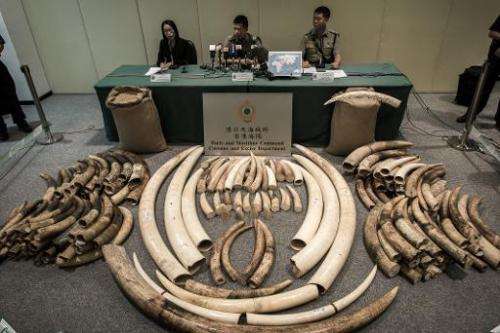Hong Kong to destroy almost 30 tonnes of ivory

Hong Kong said Thursday it would incinerate almost 30 tonnes of ivory seized from smugglers, in the world's largest such operation, following intense pressure from conservation groups.
A government committee on endangered species agreed unanimously on the move to discourage the illegal trade, its chairman Paul Shin told reporters.
Authorities will incinerate about 28 tonnes of the government's total 29.6 tonne stockpile.
"The incineration of 28 tonnes of ivory is the largest in the world," a government spokesman told a press conference, adding that the ivory will be cut into smaller pieces and then burned at 800 to 1,000 degrees Celsius.
Authorities expect the disposal to start in the first half of this year and to take one to two years, with future ivory seizures to be destroyed "on a regular basis".
"We hope to send a strong message that illegal elephant poaching to harvest their tusks, to illegally buy and sell and to transport ivory through Hong Kong... is not allowed," said Shin, a marine biologist.
Hong Kong has been a transit point for the illegal ivory trade. The southern Chinese city has seen tusk seizures rise steadily since 2009, reaching a record of 8,041 kilograms seized in 2013.
Authorities have seized a total of 33.37 tonnes of tusks since 2003, mostly shipped from African nations by sea. Some 400 kilograms of the stockpile has been donated to schools for educational purposes, and some has already been incinerated in test runs.
Conservationists praised the decision but some questioned why the government decided to keep a small portion of the stockpile.
"I wish I brought some champagne! I applaud the government's decision, it is a very good first step to take," endangered animals activist Sharon Kwok of Wild-Aid told AFP.
However, "nothing is good enough until the job is done", Kwok said of the remaining tusks.
The remaining ivory will be used for scientific, enforcement, identification and educational purposes, authorities said.
"Whilst we applaud the government in taking this first step, the timeframe is too long," Hong Kong for Elephants campaigner Alex Hofford told AFP.
The duration of two years makes it easier for the government to backtrack on its decision, Hofford said.
The government spokesman said the incinerator's capacity was limited and a two-year timeframe was needed.
The Chinese government crushed a pile of ivory weighing more than six tonnes in one go earlier this month, its first public destruction of ivory, to discourage the illegal trade.
Surging demand for ivory in Asia is behind the ever-mounting death toll of African elephants, conservationists have said.
Experts believe that most illegal ivory is headed to China—where products made from the material have long been seen as status symbols.
The US crushed six tonnes of ivory in November while the Philippines destroyed five tonnes of tusks in June, and Kenya set fire to a pile weighing the same amount in 2011.
Ivory trading was banned in 1989 under the Convention on International Trade in Endangered Species, an international agreement between governments, but poaching has continued.
The environmental group WWF estimates there could be as few as 470,000 African elephants left.
© 2014 AFP





















